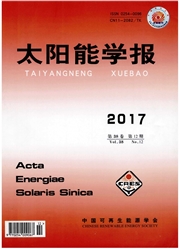

 中文摘要:
中文摘要:
采用基于有限元的数值模拟方法,建立微晶硅衬底上单个金属纳米颗粒与光相互作用的三维(3D)模型,分别计算不同半径的Ag、Al、Au和Cu球状纳米颗粒的散射截面、吸收截面、散射效率及耦合效率。结果表明:随着金属纳米球半径R的增大,表面等离激元偶极共振峰发生红移且展宽,同时颗粒的归一化吸收截面快速下降;在中长波段(500-1100nm),颗粒的散射效率随R的增大而增大,但耦合效率则呈现单调下降趋势。在相同尺寸的Ag、Al、Au和Cu颗粒中,Au和Cu的吸收截面较大,当R=50nm时,Au和Cu颗粒的吸收截面甚至大于其散射截面,二者在中短波段(300-550nm)的散射效率明显偏低。另外,金属纳米颗粒的耦合效率对颗粒成分变化不敏感。
 英文摘要:
英文摘要:
In this paper, we investigated the light scattering properties of the metal nanoparticle above the microcrystalline silicon (μc-Si) substrate with 3D numerical model via the finite element method. The normal scattering cross section, normal absorption cross section, scattering efficiency and coupling efficiency of Au, Ag, A1 and Cu nanoparticle with different size were calculated. The results showed that with the nanoparticle size increasing, metal surface plasmon dipole resonance wavelength is red-shifted, the resonance peak can also be broadened, and the absorption cross section decreases rapidly. The larger size increases the scattering efficiency at the wavelength range of 500-1100 nm, otherwise, leads to the decrease of the coupling efficiency. The absorption of Au and Cu particle is greater than Ag and A1 at the same size. When R=50 nm, the absorption cross section of Au and Cu is even greater than the scattering cross section so that the scattering efficiency is low clearly at the wavelength range of 300-550 nm. Besides, the coupling efficiency is not sensitive to the nanoparticle component.
 同期刊论文项目
同期刊论文项目
 同项目期刊论文
同项目期刊论文
 The simulation of physical mechanism of HTM-free perovskite organic lead iodide planar heterojunctio
The simulation of physical mechanism of HTM-free perovskite organic lead iodide planar heterojunctio 期刊信息
期刊信息
